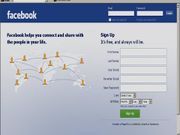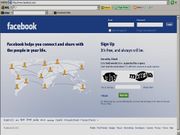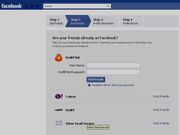Social network
Contents
- 1 Social network
- 1.1 What is Social Network?
- 1.2 History
- 1.3 Basics features of Social Network
- 1.4 Additional features of Social Network
- 1.5 Emerging trends in social networks
- 1.6 Types of Social Network
- 1.7 Effects of Social Network
- 1.8 Business model of Social Network
- 1.9 Privacy Issues:
- 1.10 Access to information
- 1.11 Potential for misuse
- 1.12 Trolling
- 1.13 Online bullying
- 1.14 Interpersonal communication
- 1.15 Patent
- 1.16 16.Investigations
- 1.17 Government applications
- 1.18 Business applications
- 1.19 Dating applications
- 1.20 Educational applications
- 1.21 Medical applications
- 1.22 Process of Registration on Facebook
Social network
What is Social Network?
A social network service is an online service, platform, or site that focuses on building and reflecting of social networks or social relation among people, e.g.,who share interest and/or activities.
History
The potential for computer networking to facilitate new forms of computer-mediated social interaction was suggested early on. Efforts to support social networks via computer mode communication were made in many early online services, including Usenet, ARPANET, LISTSERV, and bulletin board services (BBS).
Many prototypical features of social networking sites were also present in online services such as America Online, Prodigy, and CompuServe. Early social networking on the World Wide Web began in the form of generalized online communities such as Theglobe.com (1994), Geocities (1994) and Tripod.com (1995).
Many of these early communities focused on bringing people together to interact with each other through chat rooms, and encouraged users to share personal information and ideas via personal webpages by providing easy-to-use publishing tools and free or inexpensive webspace. Some communities - such as Classmates.com - took a different approach by simply having people link to each other via email addresses.
In the late 1990s, user profiles became a central feature of social networking sites, allowing users to compile lists of "friends" and search for other users with similar interests. A Social networking method was developed by the end of the 1990s, and many sites began to develop more advanced features for users to find friends.
This newer generation of social networking sites began to blossom with the emergence of Friendster in 2002, and soon became a part of the Internet mainstream. Friendster was followed by MySpace and LinkedIn a year later, and finallyBebo. The rapid increase in social networking sites' popularity{2005} MySpace was reportedly getting more page views than Google.
Facebook was launched in 2004, and since became the largest social networking site in the world.
Today, it is estimated that there are now over 200 active sites using a wide variety of social networking models.
Basics features of Social Network
Social networking sites tend to share some conventional features. Individual users are encouraged to create profiles containing various information about them. Users can upload pictures of themselves to their profiles, post blog entries for others to read, search for other users with similar interests, and compile and share lists of contacts.
To protect user privacy, social networks usually have controls that allow users to choose who can view their profile, contact them, add them to their list of contacts, and so on. It has also become common for a wide variety of organizations to create profiles to advertise products and services.
Additional features of Social Network
Mobile social networking has become popular. In most mobile communities, mobile phone users can now create their own profiles, make friends, participate in chat rooms, create chat rooms, hold private conversations, share photos and videos, and share blogs by using their mobile phone.
Mobile phone users are basically open to every option that someone sitting on the computer has. Some companies provide wireless services which allow their customers to build their own mobile community and brand it, but one of the most popular wireless services for social networking in India is Facebook Mobile.
Emerging trends in social networks
As the increase in popularity of social networking is on a constant rise, At the forefront of emerging trends in social networking sites is the concept of "real time" and "location based." Real time allows users to contribute content, which is then broadcasted as it is being uploaded - the concept is similar to live television broadcasts.
Twitter set the trend for "real time" services, where users can broadcast to the world what they are doing, or what is on their minds within a 140 character limit. Facebook followed suit with their "Live Feed" where users' activities are streamed as soon as it happens.
Friends and nearby users can contribute their own photos and comments to that event stream, thus contributing to the "real time" aspect of broadcasting photos and comments as it is being uploaded. One popular use for this new technology is social networking between businesses.
Companies have found that social networking sites such as Facebook and Twitter are great ways to build their brand image. There are few major uses for businesses and social media: ===
•To create brand awareness, as an online reputation management tool, for recruiting,
• To learn about new technologies and competitors, and
• As a lead gen tool to intercept potential prospects.
These companies are able to drive traffic to their own online sites while encouraging their consumers and clients to have discussions on how to improve or change products or services. One other use that is being discussed is the use of Social Networks in the Science communities. Social networks are also being used by teachers and students as a communication tool.
Because many students are already using a wide-range of social networking sites, teachers have begun to familiarize themselves with this trend and are now using it to their advantage. Teachers and professors are doing everything from creating chat-room forums and groups to extend classroom discussion to posting assignments, tests and quizzes, to assisting with homework outside of the classroom setting. Social networks are also being used to foster teacher-parent communication.
These sites make it possible and more convenient for parents to ask questions and voice concerns without having to meet face-to-face. A final rise in social network use is being driven by college students using the services to network with professionals for internship and job opportunities.
Types of Social Network
The main types of social networking services are those which contain category places (such as former school-year or classmates), means to connect with friends (usually with self-description pages) and a recommendation system linked to trust. Popular methods now combine many of these, with Facebookand Twitter widely used worldwide; MySpace and LinkedInare the most widely used in North America; Nexopia ( Canada); Bebo, Hi5, Hyves (Netherlands),StudiVZ (Germany), i'WiW (Hungary), Tuenti (Spain), Nasza-Klasa (Poland), Decayenne, Tagged, XING, Badoo and Skyrock in parts of Europe; Orkut and Hi5 in South America, India and Central America; and Friendster, Mixi, Multiply, Orkut, Wretch, renren and Cyworld in Asia and the Pacific Islands and Twitter, Orkut and Facebook in India.
Effects of Social Network
Web based social network services make it possible to connect people who share interests and activities across political, economic, and geographic borders. Through e-mail and instant messaging, online communities are created where a gift economy and reciprocal altruism are encouraged through cooperation.
Social networks are providing a different way for individuals to communicate digitally. These communities of hypertexts allow for the sharing of information and ideas, an old concept placed in a digital environment.
Business model of Social Network
Few social networks currently charge money for membership. In part, this may be because social networking is a relatively new service, and the value of using them has not been firmly established in customers' minds. Companies such asMySpace andFacebook sell online advertising on their site. Social networks operate under an autonomous business model, in which a social network's members serve dual roles as both the suppliers and the consumers of content.
Privacy Issues:
On large social networking services, there have been growing concerns about users giving out too much personal information Privacy on social networking sites can be undermined by many factors.
For example, users may disclose personal information, sites may not take adequate steps to protect user privacy, and third parties frequently use information posted on social networks for a variety of purposes.
"For the Net generation, social networking sites have become the preferred forum for social interactions, from posturing and role playing to simply sounding off.
However, because such forums are relatively easy to access, posted content can be reviewed by anyone with an interest in the users' personal information.
Access to information
Many social networking services, such as Facebook, provide the user with a choice of who can view their profile. This prevents unauthorized user(s) from accessing their information.
Parents who want to access their child's MySpace or Facebook account have become a big problem for teenagers who do not want their profile seen by their parents.
By making their profile private, teens can select who may see their page, allowing only people added as "friends" to view their profile and preventing unwanted parents from viewing it.
Teens are constantly trying to create a structural barrier between their private life and their parents. To edit information on a certain social networking service account, the social networking sites require you to login or provide an access code.
This prevents unauthorized user(s) from adding, changing, or removing personal information, pictures, and/or other data.
Potential for misuse
The relative freedom afforded by social networking services has caused concern regarding the potential of its misuse by individual patrons. In October 2006, a fake
Myspace profile created in the name of Josh Evans by Lori Janine Drew led to the suicide of Megan Meier. The event incited global concern regarding the use of social networking services for bullying purposes.
Trolling
A common misuse of social networking sites such as Facebook is that it is occasionally used to emotionally abuse individuals. Such actions are often referred to as trolling. It is not rare for confrontations in the real world to be translated online.
Trolling can occur in many different forms, such as (but not limited to) defacement of deceased person(s) tribute pages, calling "Australians" "Austrians", playing online pranks on volatile individuals and controversial comments with the intention to cause anger and cause arguments.
Trolling is not to be confused with cyber-bullying.
Online bullying
Online bullying (Cyber-bullying) is a relatively common occurrence and it can often result in emotional trauma for the victim. Depending on the networking outlet, up to 39% of users admit to being “cyber-bullied”.
The teenager expresses frustration towards networking sites like MySpace because it causes drama and too much emotional stress.
There are not many limitations as to what individuals can post when online. Inherently individuals are given the power to post offensive remarks or pictures that could potentially cause a great amount of emotional pain for another individual.
Interpersonal communication
Interpersonal communication has been a growing issue as more and more people have turned to social networking as a means of communication.
Social networking sites have become popular sites for youth culture to explore themselves, relationships, and share cultural artifacts".
Many teens and social networking users may be harming their interpersonal communication by using sites such as Facebook and MySpace.
Patent
On June 15, 2010, the United States Patent and Trademark Office awarded Amazon.com a patent for "Social Networking System" based on its ownership of PlanetAll.
The patent describes a Social Networking System as “Networked computer system provides various services for assisting users in locating, and establishing contact relationships with, other users.”
The system also provides a mechanism for a user to selectively establish contact relationships or connections with other users, and to grant permissions for such other users to view personal information of the user.
The patent has garnered attention due to its similarity to the popular social networking site Facebook.
16.Investigations
Facebook is increasingly being used by school administrations and law enforcement agencies as a source of evidence against student users. The site, the number one online destination for college students, allows users to create profile pages with personal details.
Government applications
Social networking is more recently being used by various government agencies. Social networking tools serve as a quick and easy way for the government to get the opinion of the public and to keep the public updated on their activity.
The Centers for Disease Control demonstrated the importance of vaccinations on the popular children's site Whyville and the National Oceanic and Atmospheric Administration has a virtual island on Second Life where people can explore underground caves or explore the effects of global warming.
Business applications
The use of social network services in an enterprise context presents the potential of having a major impact on the world of business and work.
Social networks connect people at low cost; this can be beneficial for entrepreneurs and small businesses looking to expand their contact bases.
These networks often act as a customer relationship management tool for companies selling products and services. Companies can also use social networks for advertising in the form of banners and text ads.
Since businesses operate globally, social networks can make it easier to keep in touch with contacts around the world.
Dating applications
Many social networks provide an online environment for people to communicate and exchange personal information for dating purposes.
Intentions can vary from looking for a one time date, short-term relationships, and long-term relationships. Most of these social networks, just like online dating services, require users to give out certain pieces of information.
This usually includes a user's age, gender, location, interests, and perhaps a picture. Releasing very personal information is usually discouraged for safety reasons.
Educational applications
The National School Boards Association reports that almost 60 percent of students who use social networking talk about education topics online and, surprisingly, more than 50 percent talk specifically about schoolwork.
Yet the vast majority of school districts have stringent rules against nearly all forms of social networking during the school day — even though students and parents report few problem behaviors online.
Medical applications
A new trend is emerging with social networks created to help its members with various physical and mental ailments.
For people suffering from life altering diseases, PatientsLikeMe offers its members the chance to connect with others dealing with similar issues and research patient data related to their condition.
For alcoholics and addicts, SoberCircle gives people in recovery the ability to communicate with one another and strengthen their recovery through the encouragement of others who can relate to their situation.
Process of Registration on Facebook
1. An email id is pre-requisite for opening an account over Facebook.
2. Type http://www.facebook.com on the Address Bar
3. For new sign up type our Email id and password in the Signup dialogue box and click on Sign up for Facebook4. For Security Check please enter the words as per instructions
5. For confirmation of email address click over Confirm Your Email Address --- this redirects us to our home email login account
6. Re-login our email account and we find that we have received a mail for confirmation required for Facebook account just open that message and click over link: http://www.facebook.com/c.php?code=1069365944&email= your email address
7. We cannot login into your facebook account until we have confirmed our email account by clicking over the link
8. After clicking over the link we are redirected into our facebook account
9. We Just have to follow Step 1 , Step 2 , Step 3 and Step 4 and enter into the world’s largest network of Social relations by following Instruction .10. We have to type into the email account and we get the List of persons .
11. To join them we have to send them request for friendship
12. We get the information of the list of common friends to the visited person
13. We can also send them the request for friendship to access their account
14. In this way we can join Facebook






